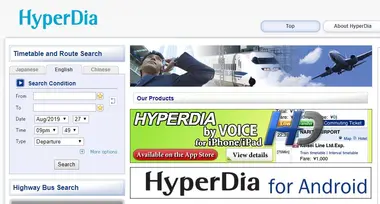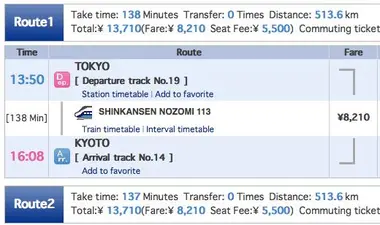Hyperdia
- Published on : 01/04/2022
- by : G.L./Ph.L
- Youtube

Le nouveau train GSE 70 000
Wikipedia
As of April 2023, Hyperdia has stopped updating its timetable details on route search service, and is thus not the recommended app for train travel anymore.
With Hyperdia being unavailable, we now highly recommed you read our article about the Jorudan application, as practical and useful for traveling by train in Japan !
Alternative Application
One of the best alternative to Hyperdia is Jorudan. It is so far the most reliable websites and applications for looking up routes, fares and travel times. It is easy to use, especially good for those who are first-timers in Japan.
The navigating application is available on Android and Apple and has a web version. Jorudan offers its service in 13 different languages, including Japanese, English, French, German and Spanish and has two versions: a free version and a premium version. Both are available on the desktop and mobile versions, and both include a Japan Rail Pass option.
Hyperdia, what is it?
Initiated in 2008 by Japan Railways to make travel simple for foreign visitors, Hyperdia is a rail app that simulates your journey throughout Japan.
The fastest way to do Nagasaki - Kagoshima via Fukuoka? Cheapest train to Sendai from Nikko? Hyperdia provides schedules, train information, price and travel times.
- Read also: Take the train in Japan
Gathering information for each train online and stations circulating in the country, the application makes it possible to easily determine which path will be the fastest to connect point A to point B. But not only that, but Hyperdia also makes it possible to know the timetables of the trains at any time of the day and night, the travel time between each connection, and the fare of each simulated route. In short, it is one of most essential app to download for your trip to Japan!
This is why much Japanese use it daily!
How to use Hyperdia?
Although Hyperdia's database is as dense as the rail network it covers, the app is relatively easy to use.
You just need to fill in the "from" and "to" fields of the search tab using the names of the stations proposed by Hyperdia according to the letters typed, then to specify the dates and times of departure or arrival of the journey you wish to make.
Note that it is also possible to indicate the number of connections accepted per trip ("route outputs"), as well as the type of train you would like to use (express, local, Shinkansen, metro, etc.). Be careful though, if you have a Japan Rail Pass, don't forget to uncheck the "Nozomi / Mizuho" boxes in the transport categories! These trains cannot be used with the JR Pass!
- Read also: The Ekiben, the train bentô
To go further: Hyperdia Highway bus and Hyperdia mobile
Very practical and easy to use, Hyperdia is a huge success in Japan! This is why Hitachi System (the company behind the modeling of the application) has decided to push the limits of the application even further by also creating a database for long-haul buses!
Once the data is entered, all you have to do is look at the search results. These are classified by increasing times (from the earliest to the latest) by indicating at the top (facing Route x) the travel time, the number of connections, and the price of the journey (for the Shinkansen the price of the ticket and that of the reservation), and below the trip details (stations and timetables).
To go further, also know that it is possible to check the specific timetables at each station for a given train (by clicking on "Train timetable") as well as the plan of the surroundings of the latter (by clicking on "Map", to the right).
- Read also: Take the bus in town
If you are interested in Hyperdia (train or bus), finally know that the app is now available on iPhone and Android. Its use is free for 30 days , and a major advantage: its vocal mode ("Hyperdia by voice") allows it to be used by simply saying the name of the stations!
Called Highway Bus Search, the bus version of Hyperdia takes the form of a small search tab placed just below the trains. It simulates a bus trip between two large Japanese cities, and its use is even simpler than that of the " classic" Hyperdia since it suffices to indicate the places of arrival and departure of the trip as well as the date of departure scheduled for the latter to generate all the trains that run that day between the two destinations.
In addition to the average price and the configuration of the seats (equipped with USB socket, integrated sleeper mode, etc.), the search results will also indicate here the various stops on the route, as well as the times at which they will potentially be reached (the bus being dependent on traffic let us not forget).
Comparatif des différentes applications : Google Maps, Japan Travel by Navitime et Japan Official Travel App
Google Maps excelle par sa polyvalence et sa facilité d'utilisation. L'application propose une interface intuitive et dispose d'une excellente cartographie qui permet de visualiser clairement les trajets. Elle est particulièrement performante pour les itinéraires complexes mêlant différents modes de transport (train, métro, bus, marche) et offre des fonctionnalités de navigation GPS en temps réel, à condition de disposer d'une connexion internet.
Le système de recherche de Google Maps est très complet et parvient souvent à trouver d'excellents itinéraires en utilisant des lignes locales de bus, parfois difficiles à repérer sur d'autres applications. C'est donc un outil particulièrement utile pour ceux qui prévoient de voyager dans des régions moins bien desservies en train, comme Shikoku, Hokkaido ou Kyushu.
Cependant, Google Maps présente une limitation majeure : l'impossibilité de filtrer les trajets en fonction du Japan Rail Pass. Pour les voyageurs utilisant ce pass, il peut être difficile d'identifier rapidement quelles lignes sont couvertes et lesquelles nécessitent un paiement supplémentaire.
Japan Travel by Navitime se distingue par sa spécialisation dans les voyages au Japon. L'application permet de filtrer les résultats en fonction du Japan Rail Pass que l'on possède, affichant automatiquement les trajets "gratuits" couverts par le pass. Tous les types de pass sont pris en compte, y compris les pass régionaux et les pass de métro des grandes villes.
Un autre atout majeur de Navitime est la possibilité d'accéder aux fiches horaires de chaque gare, permettant de voir tous les départs de train pour une destination donnée sur une semaine. Cette fonctionnalité est particulièrement utile pour connaître rapidement l'amplitude du service, notamment l'heure du premier et du dernier train du jour.
L'application propose également une fonction "voyage" qui permet de mettre en favoris des lieux, hôtels ou restaurants pour les retrouver facilement. Elle est disponible en français, bien que la traduction soit parfois approximative. Toutefois, depuis 2023, certaines fonctionnalités avancées nécessitent un abonnement premium (environ 15€ par mois).
Japan Official Travel App, développée par l'Office du tourisme national japonais, était une application très complète qui combinait information sur les transports et conseils touristiques. Elle permettait de filtrer les résultats en fonction du Japan Rail Pass et offrait des versions numériques de tous les plans de métro des grandes villes japonaises.
L'application contenait également des informations pratiques comme les numéros de téléphone d'urgence à utiliser et la liste des ambassades étrangères au Japon. Cependant, il est important de noter que Japan Official Travel App n'est plus disponible depuis fin 2023, ce qui réduit les options pour les voyageurs.
Comment choisir la meilleure application selon votre type de voyage et l'utilisation du JR Pass
Le choix de l'application idéale dépend largement de votre itinéraire et de vos besoins spécifiques. Si vous prévoyez un circuit classique entre les grandes villes japonaises (Tokyo, Kyoto, Osaka, Hiroshima) et que vous utilisez principalement le réseau ferroviaire, Japan Travel by Navitime ou Jorudan seront probablement vos meilleures options grâce à leur filtre JR Pass.
Pour ceux qui utilisent un Japan Rail Pass, il est vivement recommandé de privilégier des applications offrant une fonction de filtrage spécifique. Cela vous permettra d'identifier facilement les trains couverts par votre pass et d'éviter les mauvaises surprises. Jorudan est particulièrement efficace à cet égard, car sa version gratuite inclut cette fonctionnalité essentielle.
Si vous prévoyez de sortir des sentiers battus et d'explorer des régions moins touristiques, Google Maps pourrait s'avérer plus utile grâce à sa couverture exhaustive des transports locaux, y compris les bus ruraux. Dans ce cas, il peut être judicieux de combiner Google Maps avec une application spécialisée comme Navitime pour bénéficier des avantages de chacune.
Pour les voyageurs qui envisagent de prendre régulièrement un trajet en bus longue distance, Jorudan offre généralement des informations plus complètes sur ces services. En revanche, pour les déplacements urbains en métro, toutes les applications mentionnées fournissent des informations fiables.
N'hésitez pas à utiliser plusieurs applications en complément lors de votre voyage. Par exemple, vous pourriez consulter Navitime ou Jorudan pour planifier vos trajets en train avec le JR Pass, puis utiliser Google Maps pour la navigation en temps réel une fois sur place. Cette approche combinée vous permettra de bénéficier des points forts de chaque service.
En définitive, bien qu'aucune application actuelle n'arrive tout à fait à remplacer l'ancien Hyperdia dans toutes ses fonctionnalités, les alternatives disponibles offrent des solutions efficaces pour planifier vos déplacements au Japon. L'essentiel est de choisir l'outil qui correspond le mieux à votre style de voyage et à vos besoins spécifiques pour profiter pleinement de la remarquable efficacité du réseau de transport japonais. N'oubliez pas de vous procurer le Japan Rail Pass pour circuler gratuitement sur l'ensemble des lignes JR pendant toute la durée de votre séjour au Japon.













